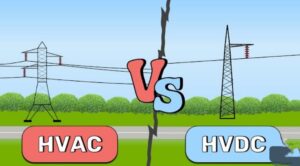
HVDC (High Voltage Direct Current) and HVAC (High Voltage Alternating Current) are two different methods used for transmitting electrical power over long distances.
Here’s how they differ:
1. Nature of Current:
– HVDC: HVDC systems transmit electrical power using direct current (DC). This means that the current flows continuously in one direction, from the sending end to the receiving end.
– HVAC: HVAC systems, on the other hand, transmit electrical power using alternating current (AC). In AC systems, the direction of current alternates periodically, typically at a frequency of 50 Hz or 60 Hz.
2. Voltage Levels:
– HVDC: HVDC systems operate at high voltage levels, typically in the range of hundreds of kilovolts (kV) to several megavolts (MV).
– HVAC: HVAC systems also operate at high voltage levels, usually in the same range as HVDC systems.
3. Transmission Efficiency:
– HVDC: HVDC transmission lines generally offer lower losses over long distances compared to HVAC lines. This is because DC transmission lines have lower electrical losses due to reduced skin and proximity effects, as well as lower reactive power losses.
– HVAC: HVAC transmission lines may experience higher losses, especially over long distances, due to factors such as skin effect, corona discharge, and reactive power losses.
4. Converter Stations:
– HVDC: HVDC systems require converter stations at both ends of the transmission line to convert AC to DC at the sending end and DC back to AC at the receiving end.
– HVAC: HVAC systems do not require converter stations for power conversion. Instead, they use transformers to step up the voltage for transmission and step it down for distribution.
5. Applications:
– HVDC: HVDC systems are often used for long-distance transmission of large amounts of power, interconnecting asynchronous AC systems, transmitting power between regions with different frequencies, and connecting remote renewable energy sources to the grid.
– HVAC: HVAC systems are the conventional choice for most electricity transmission and distribution networks, especially for short to medium distances.
In summary, HVDC and HVAC systems differ in terms of the nature of current, voltage levels, transmission efficiency, the need for converter stations, and applications. Each has its advantages and disadvantages, and the choice between HVDC and HVAC depends on factors such as distance, power capacity, cost, and system requirements.